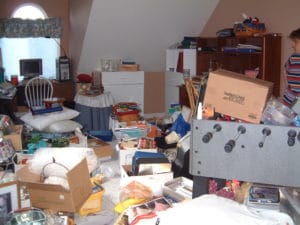Working With Clients Who Have ADHD – A Case Study
ADHD is caused by a neurobiological difference in the brain, which can interfere with such areas as learning, cognitive and organizational processing, socialization, and general life performance.
Client Background
Angela discovered and communicated to me that when her son was diagnosed with ADHD, she too was diagnosed with ADHD. When a child has ADHD, one or both of the parents have ADHD. Angela was relieved to find out there is a reason why she is the way she is, and now with medication, she was eager to clear her clutter and set up systems to keep her home organized. Angela contacted me in 2003, my first year in business, and I had no clue how ADHD affects a person’s ability to organize.
Condition of the Environment
Level 1 on the Clutter-Hoarding Scale. A beautiful home. Most spaces cluttered. Paper (years of it) was kept in beautiful baskets and bags. Every time the cleaning service came to clean the home, all surfaces were swept of paper into these baskets and bags and then never looked at again.
Techniques Used to Work with Angela
We spent several days sorting those years of bags and baskets of paper. Then I set up a prepackaged file system for her and taught her how to use it by filing the papers she kept into the system.
Once we completed that process, I had apparently gained her trust, because Angela said to me, “Anne, I have a room I would like to show you that I think I want you to help me with.”
I said, “Great, where is this room?”
She said, “Upstairs. It’s the bonus room.” For those who are not familiar with a bonus room, for the past two decades or more, American homebuilders have expanded homes from having one- or two-car garages to three or four. Above the garage, they build a vast space and call it the bonus room, meaning the homeowner can use the area however they want. And therein lies the problem; it is an undefined, un-purposed space. The picture below was Angela’s bonus room before we worked together.


I asked Angela what she wanted to do in this space. She gave my question some thought and replied, “Well, I like to decorate the house for the different seasons, so I want to store home décor here. And I like to create memory books and other craft projects. Maybe play the guitar and hang out.” Angela defined her space as her “creativity center” to give it purpose to help us determine the criteria for what would stay in the creativity center and what didn’t belong there. The technique is defining the purpose of the space and what activities will take place in the space to determine what remains and what is jettisoned.
The next week, we sorted and purged her bonus room based on those activities, and below is a photo of the results.
Other Techniques For Working with Clients With ADHD
Find out how and where clients work the best. ADHD individuals are sometimes distracted by sounds that may not distract others. And others with ADHD do better with music playing while they organize and complete tasks.
- Timers or an alarm clock help ADD clients to stay on schedule. Timers also help teach clients how to estimate time—how long tasks take.
- Visuals are usually a must for ADHD clients. Calendars, wipe-and-write boards, Post-It notes, or pictures are a few visuals that create reminders for the client.
- Assist clients in making homes for things where they use them. This way, they won’t get distracted looking for lost things.
- A key technique I use is to have the client ask questions out loud. Hearing what one needs to do can move the decision-making process along.
- Teach your clients to do one task at a time—no multitasking! Examples of this include collecting trash from all over the house at the same time or putting all dishes in the dishwasher at one time.
Any Resistance
Not great resistance. Angela wanted to keep more than I recommended—mostly paper, because of fear. But overall, she was highly motivated to clear out the clutter. Once she was on medication for her ADHD, everything became three-dimensional, where before the clutter was wallpaper to her, and she didn’t see it.
Results
Angela has maintained the space since August 2003, she lost fifty pounds as a result of our work together, and she has taught friends how to set up a paper management system.
More magazine interviewed Angela about the best investment she ever made in her life, which was hiring a professional organizer. A few quotes from the article I would like to highlight are:
“‘Give me a pile of mail, and you might as well strangle me,’ Angela Coel says. At least, that was the old Coel. For years, although she managed to stay ahead of the curve at work, Coel always felt as if her ‘tail were on fire.’ And when she quit her job to stay at home with her kids, her chronic level of disorganization overwhelmed her.”
“Then, in 2002, Coel was diagnosed with attention deficit disorder, began taking Ritalin, and started looking at things differently. Rather than seeing her problems as a moral failing, she began to view them as practical issues to be fixed. She decided to get help from someone whose skills complemented her own—a professional organizer.”
What I Know Now That I Wish I Had Known Then
- How difficult it is for a person with ADHD to get anything done—the daily struggles they have.
- The ADHD client feels tremendous shame because they often hear that they are “lazy,” “don’t care,” and “are slobs.” They constantly feel judged.
- The value of coaching, either integrated with the organizing, or one person working with her as an ADHD coach and another as the side-by-side organizer. Clients with ADHD benefit greatly from coaching to be accountable, stay focused, and receive positive affirmations about their progress.
- An understanding of how to reduce distractions and keep clients focused and activated during the organizing process.
- Medication helps tremendously to “activate” someone with ADHD; otherwise, they know they need to be doing something but can’t get started.


